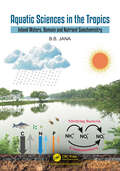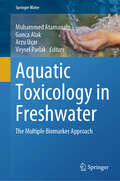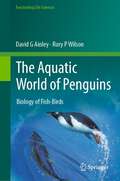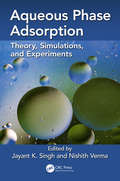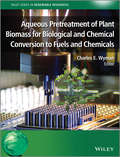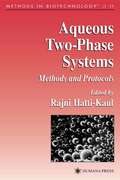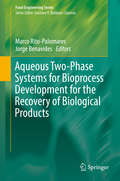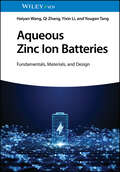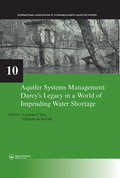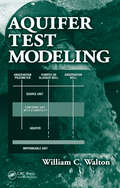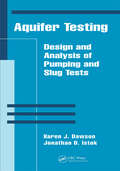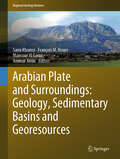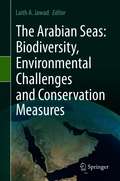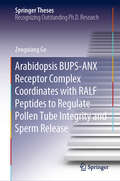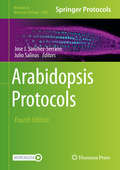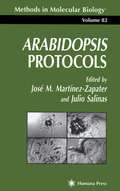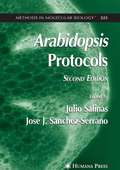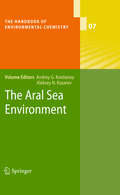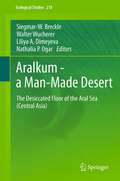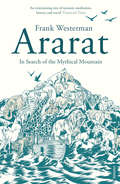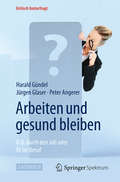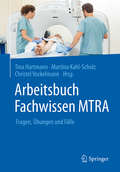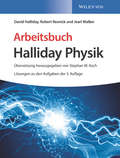- Table View
- List View
Aquatic Sciences in the Tropics: Inland Waters, Domain and Nutrient Geochemistry
by B.B. JanaThe tropical environment is unique due to its geographic location, climatic features, intense solar radiation, high temperature, heavy precipitation, less seasonal variation, enhanced food and productivity, faster metabolism, ecological dynamics and co-evolutionary processes that favor niches for specialized species. It also provides the richest biodiversity with endemic fish species that support millions of people in rural areas. This book Aquatic Sciences in the Tropics: Inland Waters, Domain and Nutrient Geochemistry comprises nine primary chapters that address various topics. Chapter 1 covers topics such as Water as a Substance, Water as a Medium, Fundamentals of Global Water Distribution and Hydrologic Cycle, Economics of Water and Challenges; Chapter 2: The Environment, Tropical Environment, Concept of Biosphere and Aquatic Biome, Tropical Aquatic Bionetwork, Tropical Limnology; Chapter 3: Origin of Lakes, General Classification of Lakes, Tropical Lakes, Lake Morphometry, Morpho-Edaphic Index, Trophic State Index of Lakes, Wetlands, Mangroves; Chapter 4: Concept of Stream Order, Streams and Rivers, The River Continuum Concept, Physico-chemical and Biological Features of Streams, Adaptations of Hill Stream Fishes; Chapter 5: Light as an Entity, Thermal Regime, Thermal Stratification, Lake Mixing, Turnover and Circulation; Chapter 6: Sources of CO2 in Inland Waters, Hydrogen Ion Concentration, The CO2–CO3–HCO3 System, Alkalinity, Hardness; Chapter 7: Dissolved Oxygen, Oxidation and Reduction Potential; Chapter 8: Total Dissolved Solids, Dissolved Organic Carbon; Chapter 9: Origin of Atmospheric Gases, Carbon and Carbon Cycle, Nitrogen, Nitrogen Fixation, Ammonification, Nitrification and Comammox, Denitrification and Anammox, Phosphorus and Sulphur.It is anticipated that the academic community, students, teachers, instructors, researchers, colleges, universities, institutions, administrators, policy makers, public libraries and the general public with an interest in these topics will find this text to be a valuable source of information and provide in-depth knowledge.
Aquatic Toxicology in Freshwater: The Multiple Biomarker Approach (Springer Water)
by Muhammed Atamanalp Gonca Alak Arzu Uçar Veysel ParlakThis book will provide an important source of practical information on the history of toxicology, the ways in which pollutants reach model organisms used in toxicology, sampling methods for research, mechanisms of toxicity and responses of aquatic organisms to toxic agents, as well as the use of therapeutic agents in current approaches. Determining the importance of environmentally friendly substances on antioxidant defense is an obvious area of future research.The combined use of a biomarkers range that can indicate exposure to pollutants and measure their effects on living organisms enables a more comprehensive and integrative assessment of indicator organisms in the aquatic environment, both biochemically and cellularly. In conclusion, the multiple biomarker approach had received great interest in ecotoxicological research and had recently been adapted to both field and laboratory studies.
The Aquatic World of Penguins: Biology of Fish-Birds (Fascinating Life Sciences)
by David G Ainley Rory P WilsonCenturies ago, when penguins were first encountered by European explorers, they were not thought to be birds but rather a fish-like relative. Subsequent accumulation of knowledge has shown penguins to be an avian species with unrivaled aquatic attributes, owing to a number of evolutionary adaptations: shape change, low drag, ability to regulate buoyancy, and extraordinary surface compliancy from their featheration. They are indeed the most extremely specialized diving bird, having given up flight (which otherwise is hugely advantageous) to the benefit of underwater prowess (such as speed, maneuverability and an ability to exploit an extraordinary range of depths). This flightlessness, however, also comes with costs that are substantial for a seabird (such as the inability to cover large distances quickly in reaction to ephemeral prey); and the energy needed to cope with moving through an aqueous environment, which is more resistant than air. For penguins, the high energetic costs in exploiting the ocean environment thus makes them especially sensitive to changes in food availability or their access to their prey. While a number of “penguin books” cover the natural history, mainly of breeding aspects, few address in much detail the incredible aquatic nature of these creatures. A huge amount of information has been amassed over recent past decades thanks to dramatic advances in microelectronics, bio-logging and maturation of some long-term studies of penguin life history. This work represents an integration of all these data with charts, maps and graphs, along with richly illustrated photos by experts in the field.
Aqueous Phase Adsorption: Theory, Simulations and Experiments
by Jayant Singh Nishith VermaThis book covers theoretical aspects of adsorption, followed by an introduction to molecular simulations and other numerical techniques that have become extremely useful as an engineering tool in recent times to understand the interplay of different mechanistic steps of adsorption. Further, the book provides brief experimental methodologies to use, test, and evaluate different types of adsorbents for water pollutants. Through different chapters contributed by accomplished researchers working in the broad area of adsorption, this book provides the necessary fundamental background required for an academician, industrial scientist or engineer to initiate studies in this area. Key Features Explores fundamentals of adsorption-based separation Provides physical insight into aqueous phase adsorption Includes theory, molecular and mesoscopic level simulation techniques and experiments Describes molecular simulations and lattice-Boltzmann method based models for aqueous phase adsorption Presents state-of-art experimental works particularly addressing removal of "emerging pollutants" from aqueous phase
Aqueous Pretreatment of Plant Biomass for Biological and Chemical Conversion to Fuels and Chemicals
by Charles E. WymanPlant biomass is attracting increasing attention as a sustainable resource for large-scale production of renewable fuels and chemicals. However, in order to successfully compete with petroleum, it is vital that biomass conversion processes are designed to minimize costs and maximize yields. Advances in pretreatment technology are critical in order to develop high-yielding, cost-competitive routes to renewable fuels and chemicals.Aqueous Pretreatment of Plant Biomass for Biological and Chemical Conversion to Fuels and Chemicals presents a comprehensive overview of the currently available aqueous pretreatment technologies for cellulosic biomass, highlighting the fundamental chemistry and biology of each method, key attributes and limitations, and opportunities for future advances.Topics covered include:* The importance of biomass conversion to fuels* The role of pretreatment in biological and chemical conversion of biomass* Composition and structure of biomass, and recalcitrance to conversion* Fundamentals of biomass pretreatment at low, neutral and high pH* Ionic liquid and organosolv pretreatments to fractionate biomass* Comparative data for application of leading pretreatments and effect of enzyme formulations* Physical and chemical features of pretreated biomass* Economics of pretreatment for biological processing* Methods of analysis and enzymatic conversion of biomass streams* Experimental pretreatment systems from multiwell plates to pilot plant operations This comprehensive reference book provides an authoritative source of information on the pretreatment of cellulosic biomass to aid those experienced in the field to access the most current information on the topic. It will also be invaluable to those entering the growing field of biomass conversion.
Aqueous Two-Phase Systems: Methods and Protocols (Methods in Biotechnology #11)
by Rajni Hatti-KaulRajni Hatti-Kaul and her expert coauthors combine theory, methodology, and applications in a practical collection of easily reproducible protocols for bioseparations in aqueous two-phase systems (ATPS). The protocols range from established methods to cutting-edge techniques with potential biotechnological applications. Among the methods detailed are those for ATPS preparation and characterization, for partitioning applied to soluble molecules and particulates (including whole cells, membranes, and organelles), and for the isolation and purification of proteins-including a glimpse of large-scale handling of two-phase separations. Practical and informative, with its detailed guidelines allowing researchers to adapt specific systems to their own separation needs, Aqueous Two-Phase Systems: Methods and Protocols demonstrates the scope and utility of two-phase aqueous systems in both basic and applied research.
Aqueous Two-Phase Systems for Bioprocess Development for the Recovery of Biological Products (Food Engineering Series)
by Marco Rito-Palomares Jorge BenavidesThis comprehensive and unique text presents a full overview of downstream processing useful for those new to the concept as well as professionals with experience in the area. The history and theoretical principles of Aqueous Two-Phase Systems (ATPS) are covered in depth. Information on ATPS characterization and application is included, and ATPS equilibria and system parameters that have significant effect on partition behavior are studied. Aqueous Two-Phase Systems for Bioprocess Development for the Recovery of Biological Products addresses specific applications of ATPS for the recovery and partial purification of high molecular weight compounds such as proteins, nucleic acids and polysaccharides, particulate bioproducts such as cells and organelles and low molecular weight compounds. Non-conventional strategies involving ATPS such as affinity systems, continuous liquid-liquid fractionation stages and the recovery from plant extracts are presented. Economic analysis of the application of ATPS in comparison to other fractionation techniques, particularly liquid chromatography, is considered, as are opportunity and current trends in the ATPS research area. Each chapter utilizes the contributors' experimental expertise in traditional and non-conventional ATPS strategies, as well as analysis of areas of opportunity and perspectives on the development and future applications of ATPS in both the lab and larger scale operations. The result is a thorough and singular overview of ATPS which has not been matched by any other text on the market.
Aqueous Zinc Ion Batteries: Fundamentals, Materials, and Design
by Haiyan Wang Qi Zhang Yixin Li Yougen TangAqueous Zinc Ion Batteries Pioneering reference book providing the latest developments and experimental results of aqueous zinc ion batteries Aqueous Zinc Ion Batteries comprehensively reviews latest advances in aqueous zinc ion batteries and clarifies the relationships between issues and solutions for the emerging battery technology. Starting with the history, the text covers essentials of each component of aqueous zinc ion batteries, including cathodes, anodes, and electrolytes, helping readers quickly attain a foundational understanding of the subject. Written by three highly qualified authors with significant experience in the field, Aqueous Zinc Ion Batteries provides in-depth coverage of sample topics such as: History, main challenges, and zinc metal anodes for aqueous zinc ion batteriesElectrochemical reaction mechanism of aqueous zinc ion batteries and interfacial plating and stripping on zinc anodesCathode materials for aqueous zinc ion batteries, covering manganese-based materials, vanadium-based materials, Prussian blue analogs, and other cathode materialsDevelopment of electrolytes, issues, and corresponding solutions for aqueous zinc ion batteries Separators for aqueous zinc ion batteries, development of full zinc ion batteries, and future perspectives on the technology A detailed resource on a promising alternative to current lithium-ion battery systems, Aqueous Zinc Ion Batteries is an essential read for materials scientists, electrochemists, inorganic chemists, surface chemists, catalytic chemists, and surface physicists who want to be on the cutting edge of a promising new type of battery technology.
Aquifer Systems Management: Selected Papers on Hydrogeology 10 (IAH - Selected Papers on Hydrogeology)
by Laurence Chery Ghislain De MarsilyPresented at the International Association of Hydrogeologists Dijon Symposium, this book contains 43 selected papers, grouped into six topics, that address the following issues: large aquifers, resource assessment; large aquifers, water salinity and evolution; karstic and carbonate aquifer systems; geothermal aquifer systems; aquifer contamination studies; and aquifer monitoring systems and management. In celebration of the 150th anniversary of the publication of Darcy's Law, the volume includes a summary of Darcy's life and his contribution to science, and five invited contributions on modern methods to estimate the hydraulic conductivity of aquifers.
Aquifer Test Modeling
by William C. WaltonIn recognition of the trend toward using numerical methdos for analyzing aquifer test data, Aquifer Test Modeling delineates the application of numerical Laplace inversion analytical equations and numerical models and demonstrates the use of public domain software. Written by a leading expert with over fifty years of experience, this highly practic
Aquifer Testing: Design and Analysis of Pumping and Slug Tests
by Jonathan D. Istok Karen J. DawsonNew! A practical, easy-to-use reference for the design and analysis of groundwater pumping and slug testsAquifer Testing: Design and Analysis of Pumping and Slug Tests is a complete design and analysis reference emphasizing practical solutions for engineers, scientists, consultants, and students knowledgeable in basic ground water theory. T
Arabian Plate and Surroundings: Geology, Sedimentary Basins and Georesources (Regional Geology Reviews)
by Sami Khomsi François M. Roure Mansour Al Garni Ammar AminThis book focuses on the evolution of sedimentary basins of the Arabian Plate and its surroundings. Because these sedimentary basins developed in various tectonic settings, from extensional or transtensional to flexural, transpressional or compressional, their sedimentary sequences provide unique records of the regional geology. Georesources of the Arabian Plate are also described here, including petroleum potential, reservoirs, water resources, fresh water and deep saline aquifers, as well as materials and ore deposits. The book is made by a set of papers authored by geoscientists working in both academia and industry. Numerous chapters describe some regional important geologic features and selected sedimentary basins from the Middle East, North Africa and the Arabian Peninsula domains. Other chapters focus on georesources. A particular focus is given to the geology of Saudi Arabia. This book is an important contribution to the geology of the Arabian Peninsula and its surroundings. In view of the strategic and economic importance of the regional geology and georesources of the Arabian Plate and Surroundings, this volume will constitute an important reference for a wide range of geoscientists interested in the geology of this region, especially those active in petroleum geosciences and related industry. Ultimately, readers will discover important thematic maps in this book.
The Arabian Seas: Biodiversity, Environmental Challenges and Conservation Measures
by Laith A. JawadThe Arabian Seas Marine Region encompasses marine areas from Djibouti to Pakistan, including the northern part of Somalia, the Red Sea, the Arabian/Persian Gulf, and parts of the Arabian Sea. Human pressures on the coastal and marine environments are evident throughout the region, and have resulted in harmful environmental effects. Oil and domestic, urban and industrial pollutants in several areas of this part of the world have caused local habitat degradation, eutrophication and algal blooms. Further, coastal landfill, dredging, and sedimentation, as well as nutrient and sediment runoff from phosphate mining, agriculture and grazing, and reduction in freshwater seepage due to groundwater extraction are all contributing to the degradation of coastal environments. This book discusses aspects not covered in other books on the region, which largely focus on marine biodiversity, and examines several environmental challenges that are often ignored, but which have a significant impact on the environment. Evaluating the status quo, it also recommends conservation measures and examines the abiotic factors that play a major main role in the environmental changes. Lastly, the book addresses the biodiversity of the area, providing a general context for the conservation and management measures discussed.
Arabians and Other Horses (World Book's Animals of the World)
by Karen IngebretsenIn a question and answer format the author introduces the Arabian horse and also discusses caring for a horse.
Arabidopsis BUPS-ANX Receptor Complex Coordinates with RALF Peptides to Regulate Pollen Tube Integrity and Sperm Release (Springer Theses)
by Zengxiang GeThis book summarizes the latest studies on plant reproduction and multiple aspects of signaling in reproductive development. It also presents the most advanced processes in CrRLK1L receptor and RALF peptide studies during plant development. Focusing on signaling in pollen tube integrity and sperm release regulation, it provides significant insights into the BUPS-ANX receptor complex and the corresponding ligands RALF4/19 to promote pollen tube growth with proper cell integrity. It also proposes a working model of female tissue-derived RALF34 competing with RALF4/19 from the BUPS-ANX to trigger pollen tube rupture and sperm release. Offering a detailed overview of the spatiotemporal regulation mechanism underlying the control of pollen tube integrity and sperm release, the book fills a major gap in our understanding of plant reproductive processes, and as such is a valuable resource for those working in the area of plant signaling.
Arabidopsis Protocols (Methods in Molecular Biology #2200)
by Jose J. Sanchez-Serrano Julio SalinasThis fourth edition compiles the most recent methodologies developed to exploit the Arabidopsis genome. Chapters detail access to public resources, to genetic, cell biology, biochemical and physiological techniques, and sections on genome, transcriptome, proteome, metabolome and other whole-system approaches. Written in the highly successful Methods in Molecular Biology series format, chapters include introductions to their respective topics, application details for both the expert and non-expert reader, and tips on troubleshooting and avoiding known pitfalls. Authoritative and cutting-edge, Arabidopsis Protocols, Fourth Edition aims to ensure successful results in the further study of this vital field.
Arabidopsis Protocols (Methods in Molecular Biology #82)
by Julio Salinas José M. Martínez-ZapaterInternationally recognized experts offer a comprehensive collection of significant new methods for gene mapping, cloning, and reverse genetics, as well as updated standard protocols for work with Arabidopsis genetics and molecular biology. These time-tested methods range from techniques for the successful growing of Arabidopsis to strategies for gene cloning. The sections on genetics, transformation, and gene expression analysis will be especially helpful to scientists involved in mutant analysis or in producing and analyzing transgenic plants. In many cases, the protocols can also be applied to other plant species, with minor adjustments. Serving both experienced researchers and beginners in the field, Arabidopsis Protocols will immediately become the standard reference for laboratories working with Arabidopsis, the plant of choice to approach many fundamental questions in plant biology.
Arabidopsis Protocols, 2nd Edition (Methods in Molecular Biology #323)
by Julio Salinas Jose J. Sanchez-SerranoThis collection of readily reproducible Arabidopsis protocols has been updated to reflect recent advances in plant biology, the completion of the Arabidopsis genome sequence, which is essential for studying plant function, and the development of whole systems approaches that allow global analysis of gene expression and protein and metabolite dynamics. The authors have included nearly all techniques developed in Arabidopsis, others recently adapted from the traditional work in crop species, and the most recent ones using Arabidopsis as a model system. Highlights include the most recent methods-transcriptomics, proteomics, and metabolomics - and their novel applications (phosphoproteomics, DNA microarray-based genotyping, high throughput metabolite profiling, and single-cell RNA).
The Arabs and the Stars: Texts and Traditions on the Fixed Stars and Their Influence in Medieval Europe
by Paul KunitzschThe influence of Arabic-Islamic science on European astronomy is still evident in the number of terms and star names which derive from the Arabic. These articles examine what the Arabs - and other peoples of the Islamic world - knew about the fixed stars and the constellations, and the astrological traditions they associated with them. Professor Kunitzsch shows how the early folk astronomy of the Arabs was radically altered, without being swept away, by the discovery of ancient Greek, also Indian and Persian, sources; by far the most important of these was the Almagest of Ptolemy. This knowledge was then transmitted to medieval Europe, to Byzantium and, especially, to Spain, as the articles go on to describe, and was a vital factor in stimulating the development of scientific thought in the West.
The Aral Sea Environment
by Aleksey N. Kosarev Andrey G. KostianoyThe environmental problems in the Aral Sea region continue to worsen. This volume presents the information gathered to date on various aspects of the Aral Sea environment. Specialists from institutions in Russia, Uzbekistan, France, Germany and the USA cover different topics - from the paleohistory and archaeology of the region, to the present physical, chemical and biological state of the sea, and the analysis of the runoff and deltas of the Amudarya and Syrdarya rivers. Further, the regional climate change is discussed and reasons for the progressing environmental crisis and the socio-economic problems in the region are highlighted. The Aral Sea Environment is addressed to scientists working in the fields of physical oceanography, marine chemistry, biology, and the environmental sciences.
Aralkum - a Man-Made Desert: The Desiccated Floor of the Aral Sea (Central Asia) (Ecological Studies #218)
by Siegmar-W. Breckle Liliya A. Dimeyeva Nathalia P. Ogar Walter WuchererHaving been the fourth largest lake on the globe roughly 50 years ago, today the Aral Sea no longer exists. Human activities caused its desiccation and the formation of a huge new desert, the Aralkum, which can be regarded as one of the greatest ecological catastrophes and - at the same time - the largest primary succession experiment of mankind. This volume brings together the results of international and interdisciplinary long-term studies on the new desert ecosystem and is divided into four main sections. The first section provides an overview of the physical characteristics of the area and covers geological, pedological, geomorphological and climatological aspects and their dynamics, especially dust-storm dynamics. The second focuses on the biotic aspects and highlights the spatial and temporal patterns of the flora and fauna. In the third section studies and projects aiming to combat desertification by phytomelioration and to develop strategies for the conservation of biodiversity are presented. The book is rounded off with a section providing a synthesis and conclusions.
Ararat: In Search of the Mythical Mountain
by Frank WestermanMount Ararat in Turkey is where, as biblical tradition has it, Noah's Ark ran aground and God made his covenant with mankind. Now it stands astride the fault-line between religion and science, a geographical, political and cultural crossroads, bound up with the centuries-old history of warfare between different cultures in this region. Frank Westerman takes a pilgrimage from the mountain's foot to its highest slopes, meeting along the way geologists, priests and an expedition in search of the Ark's remains, as well as a Russian astronaut who observes that 'there is something between heaven and earth about which we humans know nothing'. Ararat is a dazzling, highly personal book about science, religion and all that lies between, by one of Europe's most celebrated young writers.
Arbeiten und gesund bleiben: K.O. durch den Job oder fit im Beruf (Kritisch hinterfragt)
by Harald Gündel Jürgen Glaser Peter AngererWann hält uns Arbeit gesund und wann macht sie uns krank? Wissenschaftlich fundiert, humorvoll und anschaulich werden in diesem Werk Themen wie Arbeitsfreude und Kreativität, positive und negative Seiten der Teamarbeit, Führungskräfte als Antreiber oder Unterstützer, Wandel oder Stabilität im Betrieb, Zeitdruck und psychischer Stress versus Erholung und Freizeit, Burnout, und auch Arbeitsplatzverlust hinterfragt und dargestellt. Alle Themen werden im Hinblick auf gesunderhaltende und krankmachende Faktoren aus psychologischer und medizinischer Sicht beschrieben und mit wissenschaftlichen Befunden anschaulich belegt. Daraus werden Empfehlungen auf individueller, betrieblicher und gesellschaftlicher Ebene abgeleitet und begründet. Das Buch richtet sich vor allem an interessierte Laien, die sich die Frage stellen, wie sich engagiertes Arbeiten und eine gute (biologische, psychologische und soziale) Gesundheit miteinander vereinbaren lassen. Weitere Zielgruppen sind Unternehmensleitungen, Fach- und Führungskräfte, Arbeitnehmervertreter, Betriebsärzte, Arbeitspsychologen, Hausärzte und weitere Fachleute, die das Thema der Gefährdungsbeurteilung "Psychische Belastung" betrifft und alle, für die es zunehmend wichtiger wird, Zusammenhänge zwischen Arbeit und Gesundheit besser zu verstehen. Autoren: Peter Angerer ist Kardiologe und Arbeitsmediziner und leitet das Institut für Arbeitsmedizin und Sozialmedizin an der Universität Düsseldorf. Jürgen Glase r ist Arbeits- und Organisationspsychologe und Professor für Angewandte Psychologie an der Universität Innsbruck. Harald Gündel ist Psychosomatiker und leitet die Klinik für Psychosomatische Medizin und Psychotherapie am Universitätsklinikum Ulm.
Arbeitsbuch Fachwissen MTRA: Fragen, Übungen und Fälle
by Tina Hartmann Martina Kahl-Scholz Christel VockelmannFragen, Übungen und Fälle zum Lernen! Dieses Buch ist das ideale Begleit- und Übungsbuch zum Lehrbuch ,,Fachwissen MTRA", kann aber auch für sich stehend als Übungsbuch zur Vertiefung des MTRA-Wissens benutzt werden. Es hilft, das Gelernte zu vertiefen und durch Fallbeispiele in die Praxis zu übertragen. Nach Fällen gegliedert, werden reale Situationen beschrieben, mit Fragen und Lösungen dargestellt sowie mit zahlreichen Abbildungen versehen. An vielen Stellen kann der Leser selbst mit dem Buch interagieren, etwa bei der Beschriftung anatomischer oder radiologischer Abbildungen. Das leserfreundliche Layout mit Randspalte erlaubt zudem, eigene Notizen und Antwortmöglichkeiten ins Buch zu schreiben. Viele Kapitel und Themen, die in der MTRA-Ausbildung und dem MTRA-Arbeitsalltag zentral sind, werden hier erneut aufgegriffen und in Fallbeispielen beleuchtet: Anatomie Besonderheiten in der Pädiatrie Computertomographie Durchleuchtung Kernspintomographie Kontrastmittel Konventionelle Röntgendiagnostik Nuklearmedizin Patient im Krankenhaus Qualitätssicherung/-management RIS/PACS inkl. Datenschutz Sonographie Strahlenschutz Strahlentherapie Wissenschaftliches Arbeiten
Arbeitsbuch Halliday Physik, Lösungen zu den Aufgaben der 3. Auflage
by David Halliday Robert Resnick Jearl Walker Stephan W. Koch Matthias Delbrück Michael BärDas Arbeitsbuch zur dritten Auflage des "Halliday" hilft bei der Durchdringung des Stoffs der einfuhrenden Experimentalphysik-Vorlesungen fur Hauptfachstudierende. Es enthalt die Losungen inklusive des Losungswegs zu mehr als 2500 Aufgaben unterschiedlichen Schwierigkeitsgrades aus allen Kapiteln des Lehrbuchs. Die Aufgaben stammen aus allen Themenbereichen der Experimentalphysik und reichen von Standardaufgaben, die jeder konnen muss, bis hin zu weiterfuhrenden Aufgaben fur Fortgeschrittene. Sowohl einzeln erhaltlich als auch im Deluxe-Set mit dem Lehrbuch!
